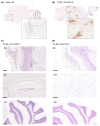V4020 Venezuelan Equine Encephalitis Vaccine: Mitigating Neuroinvasion and Reversion Through Rational Design
- PMID: 40872849
- PMCID: PMC12390694
- DOI: 10.3390/v17081136
V4020 Venezuelan Equine Encephalitis Vaccine: Mitigating Neuroinvasion and Reversion Through Rational Design
Abstract
There is a need for safe and effective vaccines against the Venezuelan equine encephalitis virus that infects both humans and equines. However, development of a live-attenuated vaccine using the TC-83 strain has been hampered by substantial reactogenicity and the potential for neuroinvasion. In this study, we demonstrate that V4020, a new TC-83-based investigational VEEV vaccine with redundant safety features preventing neuroinvasion and reversion, exhibited no neuroinvasion potential in a murine model. Following subcutaneous or intramuscular administration, a subset of mice that received the TC-83 vaccine succumbed to central nervous system infection, with replicating virus detected in the CNS, demonstrating a low, yet detectable neuroinvasion potential of the TC-83 vaccine in vivo. Sequencing analysis of the TC-83 virus recovered from the brains identified a pseudoreversion of E2 R120I, as E2 R120 is known to confer attenuation for TC-83. In contrast, V4020 showed no evidence of virus in the CNS, highlighting one of the V4020 features, a new synonymous codon to minimize reversion to the wild-type residue. Overall, our study establishes V4020 as a rationally designed, safe vaccine candidate for VEEV with significantly reduced neuroinvasion risk.
Keywords: VEE; Venezuelan equine encephalitis; live attenuated VEEV vaccine; neuroinvasion; pseudoreversion.
Conflict of interest statement
I.T. and P.P. are employees and stakeholders at Medigen, Inc., and declare no conflicts of interest. All authors declare no conflicts of interest.
Figures






Similar articles
-
Novel DNA-launched Venezuelan equine encephalitis virus vaccine with rearranged genome.Vaccine. 2019 May 31;37(25):3317-3325. doi: 10.1016/j.vaccine.2019.04.072. Epub 2019 May 6. Vaccine. 2019. PMID: 31072736
-
Venezuelan equine encephalitis vaccine with rearranged genome resists reversion and protects non-human primates from viremia after aerosol challenge.Vaccine. 2020 Apr 9;38(17):3378-3386. doi: 10.1016/j.vaccine.2020.02.007. Epub 2020 Feb 19. Vaccine. 2020. PMID: 32085953
-
Replication and clearance of Venezuelan equine encephalitis virus from the brains of animals vaccinated with chimeric SIN/VEE viruses.J Virol. 2006 Mar;80(6):2784-96. doi: 10.1128/JVI.80.6.2784-2796.2006. J Virol. 2006. PMID: 16501087 Free PMC article.
-
[The vaccines based on the replicon of the venezuelan equine encephalomyelitis virus against viral hemorrhagic fevers].Vopr Virusol. 2015;60(3):14-8. Vopr Virusol. 2015. PMID: 26281301 Review. Russian.
-
Vaccines for preventing herpes zoster in older adults.Cochrane Database Syst Rev. 2023 Oct 2;10(10):CD008858. doi: 10.1002/14651858.CD008858.pub5. Cochrane Database Syst Rev. 2023. PMID: 37781954 Free PMC article.
References
-
- Samy A.M., Elaagip A.H., Kenawy M.A., Ayres C.F., Peterson A.T., Soliman D.E. Climate Change Influences on the Global Potential Distribution of the Mosquito Culex quinquefasciatus, Vector of West Nile Virus and Lymphatic Filariasis. PLoS ONE. 2016;11:e0163863. doi: 10.1371/journal.pone.0163863. - DOI - PMC - PubMed
MeSH terms
Substances
Grants and funding
LinkOut - more resources
Full Text Sources

